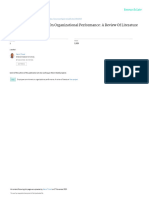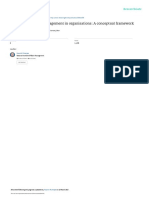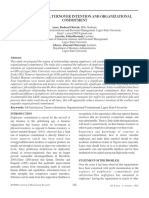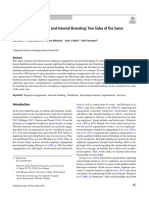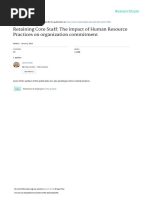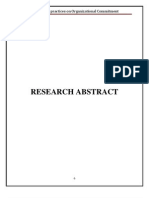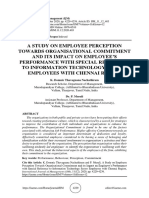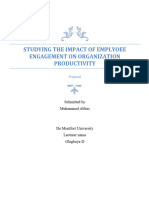Ics 1394
Ics 1394
Uploaded by
ERIC GARCHITORENACopyright:
Available Formats
Ics 1394
Ics 1394
Uploaded by
ERIC GARCHITORENAOriginal Title
Copyright
Available Formats
Share this document
Did you find this document useful?
Is this content inappropriate?
Copyright:
Available Formats
Ics 1394
Ics 1394
Uploaded by
ERIC GARCHITORENACopyright:
Available Formats
See discussions, stats, and author profiles for this publication at: https://www.researchgate.
net/publication/335911527
Facilitating Employee Retention through Employee Engagement and
Organization Commitment
Article · September 2019
CITATIONS READS
0 887
1 author:
Shiney Chib
DATTA MEGHE INSTITUTE OF MANAGEMENT STUDIES,NAGPUR
23 PUBLICATIONS 25 CITATIONS
SEE PROFILE
Some of the authors of this publication are also working on these related projects:
Role Conflict & Role Ambiguity View project
All content following this page was uploaded by Shiney Chib on 19 September 2019.
The user has requested enhancement of the downloaded file.
Journal of Information and Computational Science ISSN: 1548-7741
Facilitating Employee Retention through Employee
Engagement and Organization Commitment.
DR.SHINEY CHIB
DATTA MEGHE INSTITUTE OF MANAGEMENT STUDIES
Abstract:
Employee engagement acts as a key business driver for organizational success and excellence.
High levels of engagement in organization promotes organization commitment, retention of
talent, improves organizational performance and stakeholder value. Employee engagement is
influenced by many factors—like workplace culture, organizational communication, leadership
styles, trust and respect among the employees. Employee engagement is the level of commitment
and involvement an employee shows towards his organization and its values. It can be measured
by looking to the degree of involvement people show to their job, colleagues and organization.
Organizational commitment, fosters low turnover and absentee-ism, and contributes towards,
higher productivity. The purpose of this paper is to investigate the relationship between
employee engagement, organizational commitment and employee retention. Random sampling
method is adopted for the study.
Key words: Employee engagement, Organizational commitment, Employee retention
INTRODUCTION
Employee engagement, employee commitments and employee retention are critical
organizational requirements in this global era. These terminologies play a very crucial role in the
effective functioning and sustainability of the organization. There are various studies showing
the relationship between organizational performance and employees' engagement, for example,
Simpson (2009) and Andrew and Sofian (2012). Studies in western developed countries show
that there is a direct relationship between employee engagement, employee commitment and
employee retention. (Richardsen et al., 2006; Llorens et al., 2006; Hakanen et al., 2006; Saks,
2006; Demerouti et al., 2001; Maslach et al., 2001; Brown and Leigh, 1996). This study is an
effort to study the impact of employee engagement and organizational commitment on exit
decision of the employee. The paper is structured as follows. First the literature on the
relationship between employee engagement, organizational commitment and employee retention
were reviewed, in order to get the theoretical frame work.
Volume 9 Issue 9 - 2019 478 www.joics.org
Journal of Information and Computational Science ISSN: 1548-7741
LITERATURE REVIEW AND THE STUDY HYPOTHESES
A. Employee Engagement : Employee engagement has already gained much popularity and
several researchers claim engagement has a positive relationship with customer satisfaction,
productivity, profit, employees' retention (Coffman and Gonzalez-Molina, 2002; Buckingham
and Coffman, 1999) and organizational success and profit (Richman, 2006; Baumruk, 2004).
Harter et al. (2002) argue that employee engagement is important for 'meaningful business
results and performance in many organizations'. Saks (2006) defines employee engagement as
the extent to which an individual is attentive and absorbed in the performance of his/her roles
(pp: 600-619). Job engagement refers to the extent to which an individual is actually fascinated
in the performance of his/her own individual job role (pp: 600-619).
B.Organizational Commitment: The concept of organizational commitment has generated
great attention among the researchers. Organizational commitment concept requires a great deal
of empirical studies where both contain an outcome and antecedent Mathieu and Zajac (1990).
According to Meyer and Allen, Organization commitment includes three kinds: affective
commitment, continuance commitment and normative commitment. Meyer and Allen, (1991,
p.67) define these three sorts of commitment as following: the affective commitment explains
“the employee's emotional attachment to, identification with, and involvement in the
organization”, Continuance commitment: “the awareness of the costs associated with leaving the
organization” and normative commitment represents a perceived obligation to remain in the
organization (Meyer et al., 2002).
C.Employee Retention: Organization facing severe challenges to retain good employees with
them. Retention has been viewed as ‘an obligation to continue to do business or exchange with a
particular company an ongoing basis (Zineldin, 2000). Employee retention is driven by several
factors like organizational culture, communication, strategy, pay and benefits, professional
development and succession planning (Logan, 2000). Studies on employee retention shows that
wooing existing employee through employee development programmes costs less than procuring
new employees (Davidow & Uttal, 1989). Highly satisfied employees have higher intensions of
persisting with their organizations, which discourages their exit decisions.(Mobley et al.,1979).
Many studies have validated the link between employee satisfaction and employee retention
(Anderson & Sullivan, 1993)
Volume 9 Issue 9 - 2019 479 www.joics.org
Journal of Information and Computational Science ISSN: 1548-7741
HYPOTHESIS DEVELOPMENT
After conducting the Literature Review, the author is proposing the following research
proposition.
Organizational
Commitment
Affective
commitment
Employee Continuance
engagement commitment
Normative
commitment
Employee
Retention
Hypothesis:
H1: Employee engagement is positively related to affective commitment.
H2: Employee engagement is negatively related to continuance commitment.
H3: Employee engagement is positively related to normative commitment.
H4: Employee engagement and Organizational commitment is related to employee retention.
POPULATION AND SAMPLE: Sectors included for study was Academics, banking,
manufacturing, IT companies and, hotels. Sample size was 300. Sampling used was random
sampling. Data collection tool used was questionnaire. It was classified into 2 parts:
Demographic data consisting of 6 questions. Second part was further classified into 3 sections,
namely: Employee engagement, Organizational commitment and employee retention.
MEASURES
A.Employee Engagement: Employee engagement is defined as the measure of an employee’s
emotional and intellectual commitment to their organization and its success Hewitt Associates
(2004). There are two dimensions of employee engagement, namely: job engagement and
organizational engagement.(Saks’, 2006). Employee engagement was measured with the scale
developed by Gallup(1993-1998,2006).
B.Organizational Commitment: Organizational commitment parameters are measured with
Allen and Meyer’s instrument (1990). It included three dimension: namely affective
commitment, continuance commitment and normative commitment. The three-component
organizational commitment scale was considered has the most preferred and prevailing
conceptualization of organizational commitment (Bergman,2006). The affective commitment
scale consists of six items, continuance commitment six and normative scale consist of six items.
Volume 9 Issue 9 - 2019 480 www.joics.org
Journal of Information and Computational Science ISSN: 1548-7741
C.Employee Retention: Literature review of existing literature (Agrela,et al 2008, Gale Group
2006, Thomas 2000, Boomer Authority 2009, Cunningham 2002, Walker 2001, Patrick Owens
2006) was conducted for exploring the factors of employee retention. Factors considered for this
paper was skill recognition, learning & working atmosphere, job flexibility, cost effectiveness,
training, benefits, career development, superior-subordinate relationship, compensation, loyalty,
communication and employee motivation. It included 12 items.
RESULTS
A. Response Rate
340 questionnaires were distributed. Out of that only 306 were returned for a response rate of 90
percent. However only 300 questionnaires were properly completed. 88.24 percent was the
response rate.
Table: 1: Distribution of Questionnaires
Items Number
Questionnaires distributed 340
Total responses 306
Unusable responses 6
Usable response 300
Total response rate 90.00%
Usable response rate 88.24%
B. Demographic Details
Table: 2: Demographic Profile of Respondents
Variables Percentage
Gender Male 61.6
Female 38.4
Educational Qualification Post graduate 59
Graduate 38
UG 3
Organization Type Private 69.3
Public 30.7
Academician 22.3
Sector Bank 11.8
Manufacturing 12.1
IT 27
Hotel 26.8
Martial Status Married 70.6
Single 29.4
Volume 9 Issue 9 - 2019 481 www.joics.org
Journal of Information and Computational Science ISSN: 1548-7741
From the Table 2, it can be concluded that:
61.6% were male respondent and 38.4 % were female respondent. Maximum respondents were
postgraduate and their percentage was 59% and under graduates were only 3%. Maximum
respondents were from IT sector and Hotel Industry and were 27% and 26.8%. Out of 300
respondents, 70.6% were married.
C. Reliability Test
Table: 3: Reliability Statistics
Scale Name Cronbach’s Alpha No. of Items
Employee Engagement .86 12
Affective commitment .91 6
Continuance commitment .89 6
Normative commitment .83 6
Employee Retention .78 12
Table 3 provides the values of Cronbach alpha for all the scales. It ranges from 0.78 to 0.91.
these values are above 0.7 (Hair & Anderson,2002). Thus it can be concluded that the measures
have satisfied the reliability test.
D. Means and Standard Deviations of Study Variables
In this study , 5-point Likert scale was used to collect the responses, were 1=Strongly Disagree
and 5=Strongly Agree. The mean value was further categorized into three levels namely ‘low’,
‘moderate’ and ‘high’. Mean value less than 2, was categorized as ‘low’, between 2 to 3.5 under
‘moderate’ and values above 3.5 under ‘high’ value responses, whereas standard deviation
measures the dispersion of a set of data from its mean
Descriptive statistics of Employee Engagement
Table 4 explains shows the mean and standard deviation of employee engagement.
Table :4: Descriptive statistics of Employee Engagement
Variable Mean Standard Deviation
Employee Engagement 3.76 0.844
Descriptive statistics of Organization Commitment
Table :5: Descriptive statistics of Employee Engagement
OC Dimension Mean Standard Deviation
Affective commitment 3.97 0.613
Continuance commitment 2.72 0.824
Normative commitment 3.15 0.813
Average 3.28 0.75
Volume 9 Issue 9 - 2019 482 www.joics.org
Journal of Information and Computational Science ISSN: 1548-7741
Table 5 shows the mean and standard deviation for the three dimension of organization
commitment under study, namely affective commitment, normative commitment and
continuance commitment. The table indicates that affective commitment is highest and mean is
3.97. Lowest type of commitment is continuance commitment and its value is 2.72.
Descriptive statistics of Employee Engagement
Table 6 explains shows the mean and standard deviation of employee engagement.
Table :6: Descriptive statistics of Employee Engagement
Variable Mean Standard Deviation
Employee Retention 3.58 0.82
E. Correlation Analysis
Table :7: Descriptive Statistics and Correlation
Descriptive Statistics Correlations
Mean Standard Deviation EE ER AC CC NC
EE 3.76 0.844 1
ER 3.58 0.82 .538* 1
AC 3.97 0.613 .438** .459** 1
CC 2.72 0.824 -.005* .030 .860** 1
NC 3.28 0.75 .581** .617** .451** -.032 1
*. Correlation is significant at the 0.05 level (2-tailed).
**. Correlation is significant at the 0.01 level (2-tailed).
EE=employee engagement, AC=affective commitment, CC=continuance commitment, NC=normative commitment
Table 7 provides descriptive statistics and correlation for all study variables. Employee
engagement was positively related to affective commitment (r = .438, p, 0.01) and normative
commitment (r = .581 p, 0.01), and negatively related to continuance commitment (r = -.005, p,
0.05), thus, supporting hypotheses H1, H2 and H3. Organizational engagement is similarly
positively related to employee retention (r = .538, p, 0.05). Normative commitment (r = .617, p,
0.01), continuance commitment (r=0.030, p,0.05), affective commitment (r=0.459,p=0.01) are
related to employee retention. Study shows that employee engagement and employee
commitment dimensions have a positive correlation on employee retention. This supports
hypothesis 4. All correlations were at the moderate level and none of them is considered high
(0.70 or above). Therefore, multicollinearity does not remain a dire problem in this study.
Volume 9 Issue 9 - 2019 483 www.joics.org
Journal of Information and Computational Science ISSN: 1548-7741
F. Multiple Regression Analysis
Table: 8: Multiple Regression Analysis
Model Summary
Model R R Square Adjusted R Square Std. Error of the
Estimate
1 0.659a .434 0.213 .003
a. Predictors: (Constant), OC, EE
ANOVAa
Model Sum of Squares df Mean Square F Sig.
Regression .282 2 .141 2.576 .001
1 Residual 16.280 297 .055
Total 16.562 299
a. Dependent Variable: ER
b. Predictors: (Constant), OC, EE
Coefficientsa
Model Unstandardized Coefficients Standardized t Sig.
Coefficients
B Std. Error Beta
(Constant) 3.689 .020 11.511 .000
1 EE .107 .002 .311 2.044 .000
OC .072 .0001 .147 .999 .001
a. Dependent Variable: ER
The main hypothesis predicted that the employee engagement and employee commitment are
positively related to employee retention. Multiple Regression Analysis is used to test the
Relationship between Employee Engagement, Organizational Commitment and Employee
Retention. The results of the regression analysis are shown in Table 8. The R square value
indicated that 43.3% of variance can be explained by employee engagement and organization
commitment. The regression results in Table 8 also showed that employee engagement (β =
0.311, p< .05) and Organization commitment (β = 0.147, p< .05) are significant determinants for
employee retention. This supports hypotheses H4.
DISCUSSIONS:
The purpose of this study was to investigate the impact of employee retention on employee
engagement and organizational commitment. The main research question was the relationship
of employee engagement on the three dimensions of organizational commitment (affective
commitment, continuance commitment, and normative commitment). The results of this study
Volume 9 Issue 9 - 2019 484 www.joics.org
Journal of Information and Computational Science ISSN: 1548-7741
show that the impact of employee engagement on normative commitment was stronger than on
the impact of affective commitment and continuance commitment.
Employee Engagement and Affective Commitment: The correlation analysis reveals that
affective commitment can be predicted by job engagement. This result suggests that a higher
employee engagement will result in a higher affective commitment. Further explanation for this
result is that the employee who has a positive and fulfilling work-related state of mind (Schaufeli
and Bakker, 2004) is likely to report positive attitudes towards working and exhibit greater
affective commitment. It justifies that when employees hold a positive attitude and attachment
towards their organization, they show high levels of affective commitment. The finding of the
study corroborates the fact that engaged employees are more likely to have a greater attachment
to their organization (Schaufeli and Bakker, 2004).
Employee Engagement and Continuance Commitment : The results of the study show
a significant and negative relationship between employee engagement and continuance
commitment. Conversely, when employees engagement increases, their continuance
commitment decreases and vice versa. Kahn (1990) is of the view that engagement or
disengagement at organization is affected by three psychological conditions, namely:
meaningfulness, safety, and availability. Hence, decision to continue depends on the
economic factors rather than psychological conditions. More research is required to throw
light on the unexpected result that employee engagement does not relate negatively to
continuance commitment.
Employee Engagement and Normative Commitment: The results of this study indicate
that employee engagement has a strong relationship with the normative commitment.
Moreover, the results of this study show that employee engagement has a positive
relationship with the normative commitment. This result means that employees who have
a high organizational engagement will be higher on normative commitment. The strong
correlation observed between employee engagement and normative commitment is likely
due to the fact that employee engagement is the extent to which an individual is
psychologically present as a member of an organization (Saks, 2006). Therefore, when
employees feel exhilarated and captivated as a member of the organization, they may
report high normative commitment.
IMPLICATIONS:
This study has added to knowledge by examining the relationship between employee
engagement, organizational commitment and employee retention. This study has provided
empirical evidence to support the theory, when it shows that employees feeling more engaged in
their job and organization would report high levels of affective commitment and normative
commitment. These results are in line with that of Robinson et al. (2004) who described the
engagement as a two-way relationship between the employer and employee. Previous studies
focused mainly on work engagement (e.g., Brown and Leigh, 1996; Demerouti et al., 2001;
Hakanen et al., 2006; Llorens et al., 2006; Richardsen et al., 2006).
Volume 9 Issue 9 - 2019 485 www.joics.org
Journal of Information and Computational Science ISSN: 1548-7741
LIMITATIONS AND FUTURE RESEARCH:
Although this research has made several contributions to the knowledge, it has several
limitations as follow. The first limitation of this research is related to its research design. This
study is limited to Nagpur city with a sample size of 300 only. Data is collected from the various
sectors like academics, manufacturing, IT, Hotel etc. Study can be carried out by focusing on a
particular sector instead covering various sectors. Thus the outcome will help in identifying the
problem area under the respective sector will help to find the solutions and thus will help in
reengineering the HR policies, if required. In-depth interviews with employees would be
helpful, especially because employee engagement, organizational commitment and employee
retention may vary according sectors and countries. Future studies can also be tailored to
investigate the effects of employee engagement and organizational commitment on employee
retention by, using multiple respondents in a given organization.
REFERENCES
Allen, N.J., and J.P., Meyer, 1990, “The Measurement and Antecedents of Affective,
Continuance and Normative Commitment to the Organization,” Journal of Occupational
Psychology, 63, 1-18.
Agrela,R.,Carr,R.,Veyra,V., Dunn,C.,Ellis,D.,(2008),Retention issues and tools to ensure
University of California becomes an employer of
choice.http://www.ucop.edu/cucsaldocuments
Angle, H. and J. Perry. 1981. 'An empirical assessment of organizational commitment
and organizational effectiveness.' Administrative Science Quarterly 26: 1-14.
Baumruk, R., Gorman, B. Jr, Gorman, R. E., & Ingham, J. (2006), Why managers are
crucial to increasing engagement, Strategic HR Review, 5 (2), pp 247.
Bakker, A.B., and E. Demerouti, 2008, “Towards a Model of Work Engagement,” Career
Development International, 13, 209-223.
Bergman, M., 2006, “The Relationship between Affective and Normative Commitment:
Review and Research Agenda,” Journal of Organizational Behavior, 27(5), 645–663.
Boomer Authority (2009) competitive strategies for a world class
workforce.http://boomerauthority.ning.com
Brown, S.P., and T.W., Leigh, 1996, “A Lew look at Psychological Climate and Its
Relationship to Job Involvement, Effort, and Performance,” Journal of Applied
Psychology, 81, 358-368.
Buckingham, M., and C., Coffman, 1999, First, Break All the Rules: What the World’s
Greatest Manager Do Differently. New York, NY: Simon and Shuster.
Chandranshu Sinha and Ruchi Sinha, 2002, “Factors affecting Employee Retention:A
comparative Analysis of two organizations from Heavy Engineering Industry”, European
Journal of Business and Management, 145-162.
Volume 9 Issue 9 - 2019 486 www.joics.org
Journal of Information and Computational Science ISSN: 1548-7741
Coffman, C., and G., Gonzalez-Molina, 2002, Follow this Path: How the World’s
Greatest Organizations Drive Growth By Unleashing Human Potential. New York, NY:
Warner Books, Inc.
Cunningham,S.(2002),Attracting and retaining employees in a competitive
world.http://www.insurancejournal.com/magazine/southcentra1/2002/09/16/features
Demerouti, E., A.B. Bakker, F. Nachreiner, and W.B. Schaufeli, 2001, “The Job
Demands-resources Model of Burnout,” Journal of Applied Psychology, 86, 499- 512.
Gallup (2010). The state of the global workplace: A worldwide study of employee
engagement and wellbeing. Omaha, NE: Gallup.
Gallup Organization (1992-1999). Gallup Workplace Audit (Copyright Registration
Certificate TX-5 080 066). Washington, D.C.: U.S. Copyright Office.
Gonzalez-Roma, V., W.B. Schaufeli, A.B. Bakker, and S. Lloret, 2006, “Burnout and
Work Engagement: Independent Factors or Opposite Poles?” Journal of Vocational
Behavior, 68, 165–174.
Hakanen J., A.B. Bakker, and W.B. Schaufeli, 2006, “Burnout and Work Engagement
among Teachers,” Journal of School Psychology, 43 495–513.
Hakanen, J., W.B. Schaufeli, and K. Ahola, 2008, “The Job Demands-Resources Model:
A Three Year Cross-lagged Study of Burnout, Depression, Commitment, and Work
Engagement,” Work and Stress, 22, 224-241.
Harter, J.K., F.L. Schmidt, and T.L. Hayes, 2002, “Business-unit-level Relationship
between Employee Satisfaction, Employee Engagement, and Business Outcomes: A Meta-
analysis,” Journal of Applied Psychology, 87(2), 268.
Kahn, W.A., 1990, “Psychological Conditions of Personal Engagement and
Disengagement at work,” Academy of Management Journal, 33, 692-724.
Mowday, R.T., L.W. Porter, and R.M. Steers, 1982, Employee-Organization Linkages:
The Psychology of Commitment, Absenteeism and Turnover. San Diego, CA: Academic
Press.
Nunnally, J., 1978, Psychometric Theory, 2nd Ed. New York: McGraw Hill.
Owens,P.L. 2006.One more reason not to cut your training budget:The relationship
between training and organization outcomes.Public Personnel Management,35(2):163-
171.
Richardsen, A.M., R.J. Burke, and M. Martinussen, 2006, “Work and Health Outcomes
among Police Officers: The Mediating Role of Police Cynicism and Engagement,”
International Journal of Stress Management, 13, 555-574.
Richman, A., 2006, “Everyone Wants an Engaged Workforce How Can You Create It?”
Workspan, 49, 36-9.
Saks, A.M., 2006, “Antecedents and Consequences of Employee Engagement,” Journal
of Managerial Psychology, 21(7), 600-19.
S.Chib, 2016, “Study on organizational commitment and workplace empowerment as
predictors of organization citizenship behavior, 3(3),63-73.
Volume 9 Issue 9 - 2019 487 www.joics.org
Journal of Information and Computational Science ISSN: 1548-7741
S. Chib, A.Gomkar, “The Mediating Effect of Organizational Commitment in Leadership
, Job Satisfaction and Organization Culture with Organization Citizenship Behaviour”,
10(3), 110-123
S Chib, N Ugemuge ,” Interactive Relationship between organizational citizenship
behavior (OCB) ,Organizational commitment and workplace empowerment”, 4(9),446-
455
Thomas, Kenneth W (2000). Intrinsic motivation at work-Building energy and
commitment.san Francisco:Berrett-Koehler.
Walker,J.W.(2001),”Zero Directions?”,Human resource planning,Vol.24 No.1,pp.6-8.
Volume 9 Issue 9 - 2019 488 www.joics.org
View publication stats
You might also like
- Pipefitting Full Curriculum Rev2.1Document618 pagesPipefitting Full Curriculum Rev2.1sean100% (3)
- A Conversation Book 2 English in Everyday LifeDocument306 pagesA Conversation Book 2 English in Everyday LifeNatashka Cleary97% (58)
- The Impact of Employee Engagement On OrgDocument11 pagesThe Impact of Employee Engagement On OrgEzio Auditore da FirenzeNo ratings yet
- Organizational Practices and EmployeeDocument8 pagesOrganizational Practices and EmployeeNsk SujinNo ratings yet
- A Study On Employee Engagement in Insurance Sector in MaduraiDocument4 pagesA Study On Employee Engagement in Insurance Sector in MaduraiEzio Auditore da FirenzeNo ratings yet
- Employee Commitment On Organizational PerformanceDocument13 pagesEmployee Commitment On Organizational Performancekwasi BenNo ratings yet
- Employee Engagement and Organizational Commitment: Evidence From JordanDocument22 pagesEmployee Engagement and Organizational Commitment: Evidence From JordanPhuoc Tran Ba LocNo ratings yet
- Fostering Employee Engagement in Organisations: A Conceptual FrameworkDocument18 pagesFostering Employee Engagement in Organisations: A Conceptual Frameworkakanksha singhNo ratings yet
- Job SatisfactionDocument13 pagesJob SatisfactionKaren EsrellaNo ratings yet
- Employee Engagement in The Steel IndustryDocument8 pagesEmployee Engagement in The Steel IndustryKashish barjatyaNo ratings yet
- Suomi 2019Document16 pagesSuomi 2019zumakodok710No ratings yet
- "Employee Engagement at Tata Steel": Rohini, Rajesh Kumar Upadhyay, DeepshikhaDocument11 pages"Employee Engagement at Tata Steel": Rohini, Rajesh Kumar Upadhyay, Deepshikhasomachoudhary093No ratings yet
- RetainingcorestaffDocument21 pagesRetainingcorestaffNG-FM KPMGNo ratings yet
- The Influenceof Employees Commitmenton OrganizationalDocument15 pagesThe Influenceof Employees Commitmenton OrganizationaltopexcelcomputersNo ratings yet
- iesrewardandengagemnetmp83Document26 pagesiesrewardandengagemnetmp83phirit6No ratings yet
- Effective Employee Engagement and Organizational SDocument9 pagesEffective Employee Engagement and Organizational SrevathitNo ratings yet
- Research Proposal / Synopsis: Managing Employee Retention Through Employees Engagement in An OrganizationDocument11 pagesResearch Proposal / Synopsis: Managing Employee Retention Through Employees Engagement in An OrganizationElegant EmeraldNo ratings yet
- Research Abstract: Effect of HR Practices On Organizational CommitmentDocument38 pagesResearch Abstract: Effect of HR Practices On Organizational Commitmentpranoy87No ratings yet
- Testing The Effects of Employee Engagement Work enDocument10 pagesTesting The Effects of Employee Engagement Work envdnghi68No ratings yet
- Human Resource Practices and Their Impact On Employee Commitment in The Catholic Education Agency, Diocese of Buea, SWR CameroonDocument12 pagesHuman Resource Practices and Their Impact On Employee Commitment in The Catholic Education Agency, Diocese of Buea, SWR CameroonEditor IJTSRDNo ratings yet
- Determinants of Employee LoyaltyDocument4 pagesDeterminants of Employee LoyaltyshanmcbeeNo ratings yet
- Relationship Between Personality Factors and Employee EngagementDocument14 pagesRelationship Between Personality Factors and Employee EngagementRadam RadamNo ratings yet
- Employee Engagement - Wikipedia, The Free EncyclopediaDocument8 pagesEmployee Engagement - Wikipedia, The Free EncyclopediaShayon DasvermaNo ratings yet
- Compromiso OrganizacionalDocument16 pagesCompromiso OrganizacionalAnggy AguirreNo ratings yet
- Organisational Commitment and Job Involvement Among Casual Workers The Role of Organisational JusticeDocument17 pagesOrganisational Commitment and Job Involvement Among Casual Workers The Role of Organisational Justiceghassan riazNo ratings yet
- A Comprehensive Study of Employee Engagement: Contemplating 7-D Model in View of NIFTY 50 CompaniesDocument7 pagesA Comprehensive Study of Employee Engagement: Contemplating 7-D Model in View of NIFTY 50 CompaniesIjaems JournalNo ratings yet
- Employee Engagement Tool of Talent Retention StudyDocument10 pagesEmployee Engagement Tool of Talent Retention StudyGaneshkumar SunderajooNo ratings yet
- The Influence of Flexible Work Arrangements On EmpDocument18 pagesThe Influence of Flexible Work Arrangements On EmpRIM TCUCNo ratings yet
- Empirical Approach To Measure Employee Engagement: Evidence From Indian IT IndustryDocument7 pagesEmpirical Approach To Measure Employee Engagement: Evidence From Indian IT IndustryChristiady PurbaNo ratings yet
- Articles:F019313341 With Cover Page v2Document10 pagesArticles:F019313341 With Cover Page v2SeharNo ratings yet
- Employee Engagement & It's Effectiveness at Amazon and AccentureDocument3 pagesEmployee Engagement & It's Effectiveness at Amazon and AccentureAngel c y ChenNo ratings yet
- Employees Affective Commitment and Organizational Growth in The Hospitality Industry in Rivers StateDocument12 pagesEmployees Affective Commitment and Organizational Growth in The Hospitality Industry in Rivers StateolaoluwaoyakaleNo ratings yet
- The Examination of The Relationship Between Perceived Organizational Support, Contextual Performance and Work Engagement The Role of Transformational LeadershipDocument11 pagesThe Examination of The Relationship Between Perceived Organizational Support, Contextual Performance and Work Engagement The Role of Transformational LeadershipInternational Journal of Innovative Science and Research TechnologyNo ratings yet
- The Relationship Between Career Growth and Job EngDocument12 pagesThe Relationship Between Career Growth and Job EngEmira AdrinaNo ratings yet
- Employee Engagement White PaperDocument5 pagesEmployee Engagement White PaperAnonymous AGkPX6100% (1)
- Canadore College of Applied Arts and TechnologyDocument21 pagesCanadore College of Applied Arts and Technologyashmeetkaur02022003No ratings yet
- Organisational Commitmentand Job Satisfactionamong Government EmployeesDocument18 pagesOrganisational Commitmentand Job Satisfactionamong Government Employeesopcrdoleroncr opcrdoleroncrNo ratings yet
- Impactof Managersand Senior Leadersinfluencing Employee EngangementDocument5 pagesImpactof Managersand Senior Leadersinfluencing Employee Engangementbichmeo24No ratings yet
- Communication: A Modern Dimension of Job Involvement and Employee Commitment: A Case Study of Public Health Workers in Ekiti StateDocument7 pagesCommunication: A Modern Dimension of Job Involvement and Employee Commitment: A Case Study of Public Health Workers in Ekiti StateInternational Journal of Innovative Science and Research TechnologyNo ratings yet
- Employee Engagement Tool of Talent Retention StudyDocument11 pagesEmployee Engagement Tool of Talent Retention StudyHello HeulNo ratings yet
- Employee Engagement-Software CompaniesDocument7 pagesEmployee Engagement-Software CompaniesDr. KANAGALURU SAI KUMARNo ratings yet
- Effects of Employee EngagementDocument8 pagesEffects of Employee EngagementKaye Santos Falceso100% (1)
- The Influence of Career Commitment On Organizational Commitment Among Selected Bankers in Lagos Metropolis, NigeriaDocument7 pagesThe Influence of Career Commitment On Organizational Commitment Among Selected Bankers in Lagos Metropolis, Nigeriafreya ditaNo ratings yet
- PPM 2014 04cont2 ImandinDocument14 pagesPPM 2014 04cont2 ImandinponpersNo ratings yet
- A Study On Factors Affecting Effort CommDocument16 pagesA Study On Factors Affecting Effort CommDoyoGnaressaNo ratings yet
- Important Dimensions Influencing Employee Engagement in Organizations of PakistanDocument6 pagesImportant Dimensions Influencing Employee Engagement in Organizations of PakistanMichael JohnNo ratings yet
- Antecedents and Consequences of Employee Engagement A Literature ReviewDocument6 pagesAntecedents and Consequences of Employee Engagement A Literature ReviewEditor IJLTEMASNo ratings yet
- The Impact of Financial Incentives On Employees CommitmentDocument10 pagesThe Impact of Financial Incentives On Employees CommitmentLizzy MondiaNo ratings yet
- Rationale and Objective of The StudyDocument3 pagesRationale and Objective of The Studylaurence villaluzNo ratings yet
- JETIR1901B71Document8 pagesJETIR1901B71CHAUHAN ALIAKBARNo ratings yet
- F 019313341fddlDocument9 pagesF 019313341fddlSaif UzZolNo ratings yet
- A Study On Employee Perception Towards Organisational Commitment and Its Impact On Employee's Performance With Special Reference To Information Technology Sector Employees With Chennai RegionDocument11 pagesA Study On Employee Perception Towards Organisational Commitment and Its Impact On Employee's Performance With Special Reference To Information Technology Sector Employees With Chennai RegionIAEME PublicationNo ratings yet
- 4 8 99 310 PDFDocument6 pages4 8 99 310 PDFanwesha dasNo ratings yet
- A Study On Employee Engagement in Mobis India Limited, ChennaiDocument8 pagesA Study On Employee Engagement in Mobis India Limited, ChennaiGaneshkumar SunderajooNo ratings yet
- R 1 PDFDocument11 pagesR 1 PDFArunabh ChoudhuryNo ratings yet
- Popli & Rizvi - Drivers of Employee Engagement The Role of Leadership StyleDocument15 pagesPopli & Rizvi - Drivers of Employee Engagement The Role of Leadership StyleNancy FernandezNo ratings yet
- ProposalDocument12 pagesProposalscienceblock092No ratings yet
- S.abirami Sundaravalli T.vijayakumar Ijaerv10n77spl - 21Document20 pagesS.abirami Sundaravalli T.vijayakumar Ijaerv10n77spl - 21abiramihrNo ratings yet
- Review of LiteratureDocument6 pagesReview of LiteratureSylve SterNo ratings yet
- Employee Engagement and Organizational SurvivalDocument15 pagesEmployee Engagement and Organizational SurvivalHello HeulNo ratings yet
- Profumo TestDocument1 pageProfumo TestERIC GARCHITORENANo ratings yet
- Confirmation For Booking ID # 626022388Document1 pageConfirmation For Booking ID # 626022388ERIC GARCHITORENANo ratings yet
- Internet BankingDocument1 pageInternet BankingERIC GARCHITORENANo ratings yet
- BsaDocument1 pageBsaERIC GARCHITORENANo ratings yet
- Confirmation For Booking ID # 713780448Document1 pageConfirmation For Booking ID # 713780448ERIC GARCHITORENANo ratings yet
- Paoline Gau 2019Document28 pagesPaoline Gau 2019ERIC GARCHITORENANo ratings yet
- Babor 1Document1 pageBabor 1ERIC GARCHITORENANo ratings yet
- Certificate: Bureau of QuarantineDocument1 pageCertificate: Bureau of QuarantineERIC GARCHITORENANo ratings yet
- Cabatic 1Document1 pageCabatic 1ERIC GARCHITORENANo ratings yet
- RA 7077 IRR 1991 (Signed)Document54 pagesRA 7077 IRR 1991 (Signed)ERIC GARCHITORENA100% (1)
- Terraserv - TH - Application Form - 2021-Sept 10, 2021Document2 pagesTerraserv - TH - Application Form - 2021-Sept 10, 2021ERIC GARCHITORENANo ratings yet
- How To Calculate Your Hourly RateDocument3 pagesHow To Calculate Your Hourly RateERIC GARCHITORENANo ratings yet
- Terraserv - TH - Checklist - 2021-Sept 10, 2021Document1 pageTerraserv - TH - Checklist - 2021-Sept 10, 2021ERIC GARCHITORENANo ratings yet
- Alderfer's Erg TheoryDocument6 pagesAlderfer's Erg TheoryAiman MustaqimNo ratings yet
- Selva Priyan MDocument60 pagesSelva Priyan MRaja NayakNo ratings yet
- Gregorio Cardenas Vazquez CV ResumeDocument4 pagesGregorio Cardenas Vazquez CV ResumeGreg CardenasNo ratings yet
- Sallary AllowanceDocument15 pagesSallary AllowanceKeval PatelNo ratings yet
- Mindtree Offer Letter EncryptedDocument28 pagesMindtree Offer Letter Encryptedsurendra100% (1)
- Department of Labor: 3a71dce9 0f04 4e80 8533 Aeda57aa48b0Document28 pagesDepartment of Labor: 3a71dce9 0f04 4e80 8533 Aeda57aa48b0USA_DepartmentOfLaborNo ratings yet
- Debt Relief Finance Scheme: Benefitting SmesDocument1 pageDebt Relief Finance Scheme: Benefitting SmesRobNo ratings yet
- Eric Weinstein Migration For The Benefit of All International Labour Review Vol 141 2002 No 3Document29 pagesEric Weinstein Migration For The Benefit of All International Labour Review Vol 141 2002 No 3Colin DuffyNo ratings yet
- 002 5MCSS Train The Trainer (Participant Rev0) PDFDocument222 pages002 5MCSS Train The Trainer (Participant Rev0) PDFKirstie Lou Sales100% (5)
- ADocument15 pagesARobby Tubill FardhyNo ratings yet
- Mo8 - Participate in TeamDocument77 pagesMo8 - Participate in TeamMikiyas FikirNo ratings yet
- NVIDIA Code of Conduct ExternalDocument16 pagesNVIDIA Code of Conduct ExternalCaptain ObviousNo ratings yet
- Ateneo de Davao University Jacinto St. Davao City: February 9, 2017 TTH 11:00-12:30Document3 pagesAteneo de Davao University Jacinto St. Davao City: February 9, 2017 TTH 11:00-12:30Jsn Pl Cabg-sNo ratings yet
- ManagementDocument3 pagesManagementnkhanhvy6813No ratings yet
- Probation Letter AsumanDocument2 pagesProbation Letter Asumanabigabaraphael1No ratings yet
- 2602201723-Award Staff Salary RevisionDocument43 pages2602201723-Award Staff Salary RevisionNitin MehtaNo ratings yet
- Resume Nilesh PatilDocument3 pagesResume Nilesh PatilSawrabh TaoriNo ratings yet
- Reference Letter For New EmployeeDocument8 pagesReference Letter For New Employeee6zwz633100% (1)
- Gamazan - Labor Law Rev - Assignment 2Document2 pagesGamazan - Labor Law Rev - Assignment 2Richie SalubreNo ratings yet
- Apy Chart PDFDocument1 pageApy Chart PDFDhirendra Singh patwalNo ratings yet
- Litreature ReviewDocument1 pageLitreature ReviewVanshikaNo ratings yet
- FULL REPORT Corporate Volunteering For The Post Pandemic WorldDocument266 pagesFULL REPORT Corporate Volunteering For The Post Pandemic WorldBrunoNo ratings yet
- HR Policies in IndiaDocument5 pagesHR Policies in IndiaVishala GudageriNo ratings yet
- Running Head: Net Advantage or Disadvantage of Immigrants 1Document5 pagesRunning Head: Net Advantage or Disadvantage of Immigrants 1otieno vilmaNo ratings yet
- Statement of Account: Kitty, Fitzgerald JacobDocument3 pagesStatement of Account: Kitty, Fitzgerald JacobJaysonn KayNo ratings yet
- Analyzing Factors Influencing Consumer Behavior To Use Mobile Financial Service in Bangladesh: A Study On BkashDocument77 pagesAnalyzing Factors Influencing Consumer Behavior To Use Mobile Financial Service in Bangladesh: A Study On BkashMahmudul Hassan MehediNo ratings yet
- City Hall Research - by Quiba de JosDocument7 pagesCity Hall Research - by Quiba de JosMark Kristian RocaforNo ratings yet
- Leadership & Change MGT ch1-6Document52 pagesLeadership & Change MGT ch1-6Tibebu SolomonNo ratings yet





